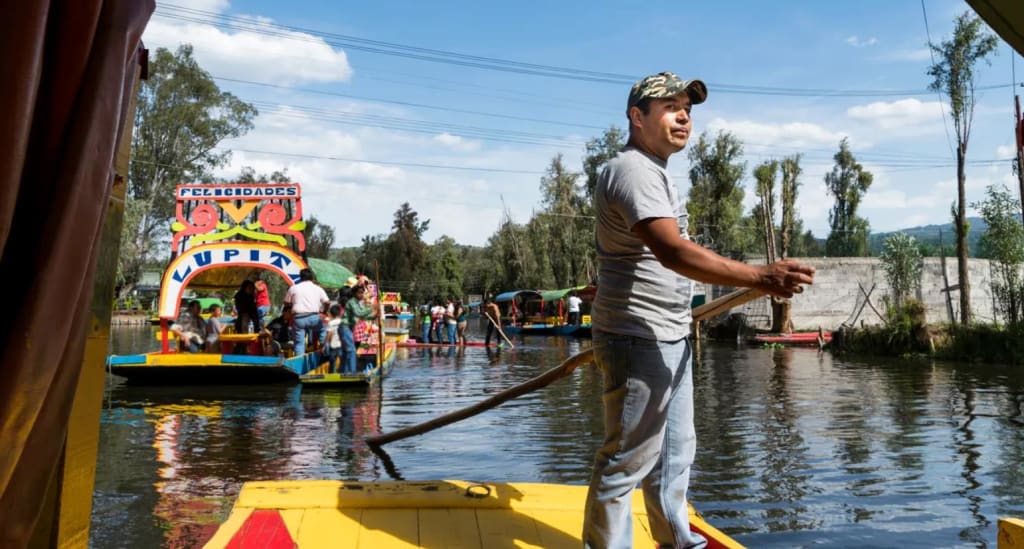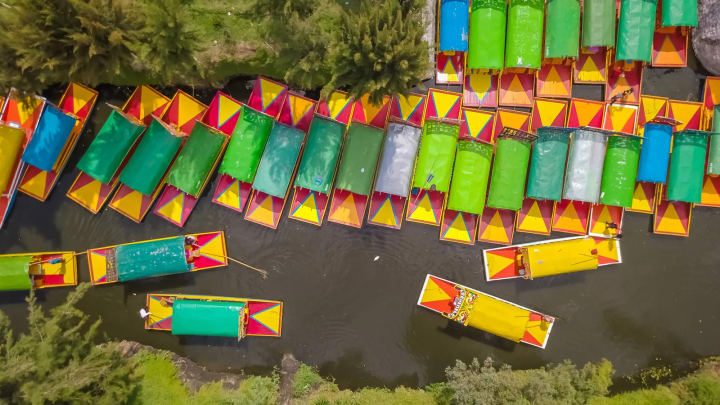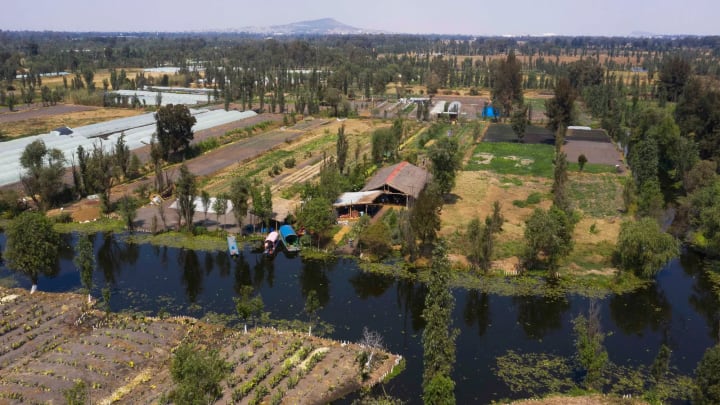The return of Aztec floating farms
In Mexico City, a 700-year-old Aztec farming technique is giving a sustainable edge to modern agriculture.

It was early on a Sunday morning, and I was in the Floating Gardens of Xochimilco, 28km south of Mexico City's historical centre. The endless maze of canals and waterways was already filling up with colourful trajineras (flat-bottomed boats) packed with day trippers from the Mexican capital. Vendors were selling grilled elotes (corn on the cob) and michelada cocktails, while a band filled the air with festive Mariachi music.
Hundreds of tourists throng the canals of Xochimilco every weekend for a flamboyant display of sombreros, food, music and art. Yet, as they cruise alongside the chinampas, or "floating gardens", most remain oblivious to the fact that they are looking at an ancient engineering wonder. These man-made island-farms are the last vestiges of a massive 14th-Century land reclamation project of the Aztec Empire that continues to feed the people of Mexico City even today.
When the Aztecs arrived in the Valley of Mexico in 1325, legend has it that they were greeted by an unusual sight on Lake Texcoco. An eagle with a snake in its beak was sitting on a prickly pear cactus on the lake's swampy shores, exactly as their gods had prophesied about the place the Aztecs would call home. The wandering tribe decided to settle down and build their capital city here. They called it Tenochtitlan.

Tenochtitlan soon turned into one of the most powerful cities in Mesoamerica – but not without running into a host of construction problems. As the Aztecs started building on the shores of Lake Texcoco, they realised there just wasn't enough land to expand on. There was water everywhere. The lacustrine landscape of Mexico Valley was covered with five big lakes: Texcoco, Xaltocan, Zumpango, Chalco and Xochimilco, and very small boggy islands.
To solve their land crisis, archaeological evidence as well as narratives of Spanish colonial writers tell us that the Aztecs came up with a genius plan: the chinampas. They artificially constructed these long, narrow strips of land over shallow lakes by piling earth on reeds and sedges and raising them to the required height. The islands were then anchored to the lake floor by a fence of ahuejote, a native willow tree.
While the Aztecs built Tenochtitlan's city centre by connecting existing islands via bridges and boardwalks, in areas further from the city centre, such as the Xochimilco lake basin, they used chinampas to create floating gardens that could be used for agriculture, animal rearing, hunting and foraging. The ingenious technique of farming on water allowed the Aztecs to sustain their growing empire.

"[Chinampas] are not just a productive and sustainable agro-ecosystem technique, but they are also representative of the Aztec culture and carry the legacy of indigenous people who taught us how to relate to nature, be part of it and live with it," said Patricia Perez-Belmont, founder of Umbela Sustainable Transformations, a non-profit organisation that creates innovative and inclusive solutions for Mexico City's environmental issues.
What resulted was a one-of-its-kind floating city spread over 13 sq km that was separated by canals and connected by causeways with more than 250,000 people living on it. When the Spanish arrived in Tenochtitlan in the 16th Century, they were stumped to see roads that were half land and half water, floating farms that were full of nature's bounty and nimble canoes that could transport hundreds of people.
Unfortunately, the Spanish went on to destroy Tenochtitlan and little of the ancient metropolis can still be seen, apart from the mosaic of manmade islands at the Floating Gardens of Xochimilco and a few ruins in the city centre.
The World Heritage-listed chinampas remain fecund and ecologically viable even today. These artificial island-farms form one of the most productive agricultural systems in the world as they are incredibly efficient and self-sustaining. That's because the soil is continuously enriched by fine sediments from the lake, plant remains and animal excrement. In addition, the ahuejote fences around each island prevent erosion, protect the chinampa against wind and pests, and act as natural trellises for vine crops. In the early 16th Century, Aztec chinamperos could grow up to seven different crops in a year that resulted in 13 times as much produce as dry land farming.
The most innovative aspect of chinampas, however, is the clever use of water. These narrow islands are packed with porous soil and rich organic matter, which allows them to absorb water from surrounding canals and retain it for a longer period. Additionally, the chinampa layers are designed in a way that allows deep-rooted crops to draw groundwater directly and use it per their needs, thus alleviating the need for external irrigation.

"Chinampas are like giant sponges; you don't need to water them, yet they can be productive all year long," said Lucio Usobiaga, founder of Arca Tierra, a grassroots organisation that works closely with the farmers of Xochimilco to implement regenerative agricultural practices. His team, along with a network of local farmers, has restored more than five hectares of Xochimilco's chinampas over the last 12 years and is committed to producing quality and flavourful food by implementing traditional Aztec technologies, such as companion planting, where mutually beneficial plants are grown close together.
Chinampas are like giant sponges; you don't need to water them, yet they can be productive all year long
Xochimilco's unique ecosystem of artificial island-farms and nutrient-rich canals also provides safe ecological niches for endemic and migratory aquatic fauna. The chinampas are home to nearly 2% of the world's biodiversity, including the critically endangered axolotl salamander, a marvellous amphibian that possesses the genetic superpower to regenerate every part of its body.
For locals, the chinampas are an expression of their cultural, economic and social identity.
"Chinampas are revered and venerated in our society. Through chinampas, we not only perpetuate the knowledge and traditions of our grandparents but also preserve our relationship with nature that is several centuries old," said Sonia Tapia, agricultural team lead at Arca Tierra.
However, farming on chinampas has its own challenges. After the Spanish conquest of Mexico in 1521 and subsequent rapid urbanisation, chinampas fell out of favour. In the second half of the 20th Century, Mexico City rapidly expanded outwards and engulfed a substantial percentage of Xochimilco's floating farms. The final blow came in the form of the Xochimilco Ecological Plan in 1987, which brought about the expropriation of 2,577 acres of communal agricultural lands and permitted an increase in urban usage such as the construction of buildings, bridges and football pitches.

"As the city reached Xochimilco, it altered the structure and the functionality of the chinampas drastically," said Perez-Belmont, explaining that many of the chinampas were taken over by the city or abandoned.
While small-scale producers continued to farm the remaining islands, the demand for agricultural produce from the chinampas declined massively. People shifted to buying cheaper alternatives from large, wholesale markets that sourced their produce from outside Mexico City. While tourism on Xochimilco's canals brought some extra income, that was not enough to sustain the families of chinamperos, who started looking for better job opportunities in downtown Mexico City.
Chinampas were starting to become an anachronism – until the Covid-19 pandemic struck in 2020. With the closing of borders and disruption of supply chains, Mexico City's largest open-air, wholesale market, La Central de Abasto, came to a standstill. In a pandemic-ridden environment, 20 million Mexico City dwellers started looking back to where their forefathers had procured their food: the chinampas.
The Covid-19 pandemic demonstrated how important local farmers and community agriculture can be for creating a healthier and more reliable food system
The chinampas were close to downtown Mexico City and were opulent and healthy coffers of fresh, sustainable produce waiting to be utilised. "The Covid-19 pandemic demonstrated how important local farmers and community agriculture can be for creating a healthier and more reliable food system," said Usobiaga.

Local organisations such as Arca Tierra played a big role in connecting chinamperos with prospective customers by creating online portals where consumers could easily order fresh vegetables, free range eggs and chinampa honey. Chinamperos liaised with programmes like Comidas Solidarias to provide food to patients, doctors and families in need during the pandemic. Their high productivity and proximity to the city centre, as well as the clear health benefits of the locally grown food, more than doubled the sales of the chinampas' business during the pandemic and encouraged chinamperos to return, finally giving these ancient floating gardens a new lease on life.
Seven hundred years after they were first built, Xochimilco's chinampas are once again feeding and sustaining Mexico City in uncertain times and unfavourable environments.
About the Creator
Sweet Holdeman
I do not ask the heavens to be pleased with my beauty, but I hope that I will always be at liberty to do so.






Comments
There are no comments for this story
Be the first to respond and start the conversation.